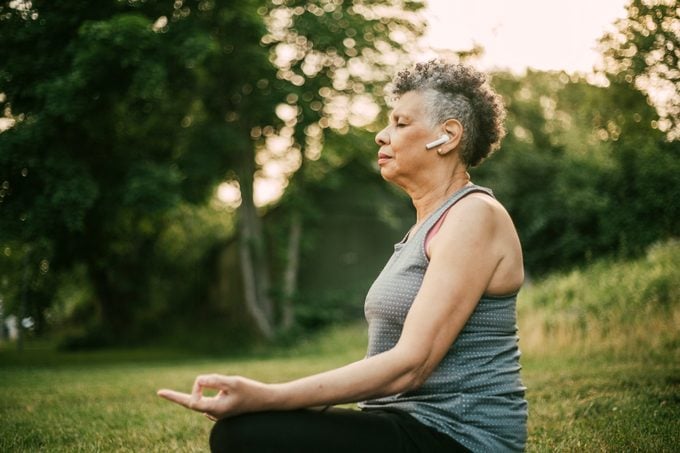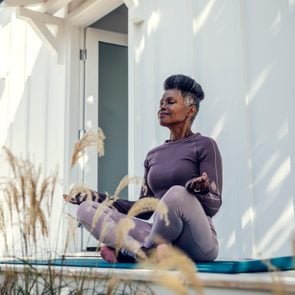How To Meditate: The Benefits, With a Guide for Beginners
Updated: Mar. 02, 2023
Thinking of starting a meditation practice but don't know where to begin? Here's how to meditate—and why it's so good for your health.
A “chill pill” for your mind
How many Americans are stressed out? Over half (55%) reported feeling very stressed on a daily basis, according to 2022 data from The American Institute of Stress. This makes the US one of the most stressed-out countries in the world, with stress levels 20 percentage points higher than the global average. (If you’re curious: Louisiana ranked as the most stressed-out state, while Montana was the most chill.)
If your reaction to those stats is “Only half of us are stressed?!” then you are probably in need of a little stress-reducing TLC…like, yesterday. Fortunately there are some great science-backed ways to lower stress and improve your happiness and wellbeing. Top of the list? Meditation.
“Think of meditation as a chill pill for your mind,” says Sherer Murray, an expert in transcendental meditation known for her TEDx talk, “The Unstoppable Power of Letting Go.”
As a formerly very stressed-out journalist, Murray says that learning to let go and quiet her mind with meditation has been life-changing. “I meditate twice a day to stay present, and grounded in what’s real, and I’m no longer at the mercy of my fears and anxieties,” she says. “I learned the hard way that the longer I tried to avoid my feelings, the longer those difficult emotions lasted and I was unable to focus on positive things.”
Deepak Chopra’s #1 Meditation for Happiness
Why should you try meditation?
It’s not just effective for Murray. In fact, meditation has been used for millennia in every culture throughout the world—because it’s accessible to everyone, easy to learn, simple to practice, and it works. The best part: All you really need is a quiet place and an open attitude—it won’t cost you a penny.
That said, many people don’t relish the idea of sitting with their thoughts, and many would rather do almost anything else. People worry about being bored or doing it wrong.
What’s more, the idea of doing nothing—even just for a few minutes—seems counterintuitive in our frenetic culture. When a society values productivity—the more conspicuous, the better—there’s little space for a quiet daily practice of sitting still.
However, meditating is doing something real, and it’s good for your health, mentally and physically, Murray says.
Meditation is an umbrella term for a set of techniques that encourage a heightened state of awareness and more focused attention on the present.
It can bring mental clarity and calm—the psychological equivalent of cleaning a messy house.
There’s also no one way to do it, which is a good thing. You can find what works for you. Maybe that’s repeating a mantra or focusing on mindfulness. Or maybe you use an app for guided meditation.
However you find your inner Zen, you’ll be joining millions of others who reap the benefits of meditation, including possible lower blood pressure levels, reduced pain, relieved stress, and better sleep. Largely due to this lengthy list of potential meditation benefits, reported meditation use is higher than ever—approximately 200 million to 500 million people engage in meditation worldwide.
This is especially true for younger and tech-savvy people with 23% of Gen Z saying they meditate or practice mindfulness to take care of their physical well-being, according to 2022 data published by Finances Online. Plus, three of the top five most downloaded health apps use meditation.
Still, if you’re thinking, “I’ve tried meditation, and I hate it,” you’re not alone. Nearly half of Americans said they had no desire to learn meditation. This may be because a lot of first-time meditators feel like they’ve failed because their minds wandered or they spent the session stressed about doing it correctly.
Not to worry. This guide will explain why you should meditate and how to meditate, especially if you’re a new to the practice.
Get The Healthy @Reader’s Digest newsletter
Benefits of meditation
Unlike a lot of trendy health practices, meditation is time-tested and comes with proof of benefits. There’s a lengthy list of evidence-backed benefits of following a meditation practice.
“Multiple studies have shown that mindfulness meditation can reduce anxiety,” says Neda Gould, PhD, director of the mindfulness program at Johns Hopkins University in Baltimore. “Anxiety and stress can trigger the brain’s fight-or-flight response and the release of stress hormones, but studies show that with meditation, this part of the brain turns off more readily.”
An online mindfulness course may reduce stress, anxiety, and fears over current events, too. Specifically, 80% of people in a recent Global Advances in Health and Medicine study reported decreased stress, 76% reported decreased anxiety, and 55% said they were less worried about Covid-19.
The American Heart Association notes that meditation can improve sleep, reduce inflammation, dim the brain’s response to pain, and help some of the symptoms of menopause.
The Society for Integrative Oncology recommends meditation as one way to reduce anxiety, mood changes, and pain and improve quality of life during cancer treatment.
Meditation can also lower blood pressure, and these benefits may still be in effect one year out, according to a study in PLOS One.
“A meditation practice—specifically mindfulness—can be particularly helpful, as the science shows it reduces stress, helps with insomnia, builds the immune system, and is helpful for working with anxiety and other challenging emotions, among other scientific findings,” says Diana Winston, director of mindfulness education at the UCLA Mindful Awareness Research Center in Los Angeles and the author of The Little Book of Being.
Meditation is generally considered safe for healthy people, but it’s not for everyone. “If it feels like it’s making you more anxious, it may not be the right approach for you,” she says.
Steve Aoki Just Dropped His #1 Biohacking Secret
How to start meditating
As with many good-for-you habits, getting started is the hardest part. But meditation doesn’t have to be difficult, says Gould.
Do you think meditation requires “thinking about nothing”? That’s one of the common meditation myths, because it doesn’t. We all have thoughts running through our heads, all the time.
During meditation, you focus your awareness on something specific—like your breathing. As thoughts and feelings arise, you observe them without judgment or reaction. Instead, you gently refocus your attention. While it sounds both simple and hard, the good news is that you can get better at it with practice.
You also don’t need to stock up on a bunch of expensive equipment to make meditation happen. “All the tools you need are internally available,” Gould says. “It’s just learning how to use them.”
With most meditation practices, you’ll need:
- A quiet place with limited distractions
- A comfortable meditation position, whether you’re sitting, lying down, or walking
- A place to focus your attention, such as a chosen word or mantra, an object, or your breath
- An open attitude to let any distractions come and go naturally and without judgement
These meditation gifts are great aids to your practice or someone else’s.
Ways to meditate
There are a lot of ways to meditate, and what works for your best friend may not work for you. That’s OK. Finding the right practice for you may take some trial and error.
Gould suggests reading about the various types of meditation to see which ones appeal to you. Give one a go and see how you like it. Not a fan? Try something else.
(Check out this list of recommended meditation books.)
Here are just some of the more popular types:
Mindfulness meditation: Based on Buddhist teachings, this practice has you pay attention to your body and thoughts, often focusing on the breath.
Transcendental meditation: With this type of meditation, you repeat a personalized mantra—like a word, sound, or phrase—to quiet your thoughts.
Walking meditation: Meditation isn’t always about sitting and breathing; it can also incorporate movement. With walking, or movement, meditation, you focus on your body, often breathing in time with your footsteps.
Loving kindness: Also called metta meditation, this practice involves directing well-wishes to others and sitting with feelings of gratefulness and compassion.
Guided meditation: With this type of meditation, a narrator talks you through the process. It often involves visualizations, which set the mood and tone.
Focused meditation: This practice involves concentrating on something around you and blocking out everything else.
Spiritual meditation: Practiced at home or in a place of worship, this meditation is similar to prayer. You can reflect on spiritual growth or look for a deeper connection in your faith.
Somatic meditation: This meditation focuses on integrating the body and mind by directing the mind to think about specific sensations in the body, working up from your toes all the way to your head.

Learning meditation
In a world built on bustling and hustling, sitting alone with your thoughts can be intimidating. And many beginners don’t know where to start.
Consider taking an online class if you find a type of meditation that appeals to you, Gould says. Make sure you choose a reputable program. Not sure how to find a good one? Many universities offer courses.
Or try a guided meditation app. “There are free apps, such as Insight Timer, which offers 80,000 guided meditations,” Gould says. “Other apps have a free portion, but you can pay for premium services.” Be sure to check out these free meditation resources too.
A few popular meditation apps include:
Meditation for beginners
Once you have found a practice that appeals to you, start small.
“Begin with five to 10 minutes and build up from there to 20 minutes,” Gould says. (Learn how long you should meditate in order to get the benefits.)
To help you lock in the habit, carve out a set time to practice. Some people prefer to meditate in the morning, before the day’s busyness pushes meditation to the bottom of their to-do list. If you’re not a morning person, waking up earlier to meditate probably won’t be a lasting strategy, Gould says. (Learn more about finding the best time to meditate for you.)
“It’s nice to integrate meditation into a routine,” she says. “You take a shower, brush teeth, meditate, and go on with your day. If you tack it on with some things you do normally, it is more likely to stick.”
Try to find some space in your home where you won’t be disturbed, and practice along with an app or on your own, says Winston.
“You begin by noticing your breathing in your body, feeling the rising and falling of your chest or abdomen, or the in and out sensations at your nose,” says Winston. “When you noticed your attention has wandered away—which it will!—then gently redirect your attention back to your breathing.”
Keep doing this over and over. Ta-da! You’ve meditated.
How to meditate properly
Gould suggests another exercise to get a feel for mindfulness meditation. It involves pausing to notice your five senses in the moment, and it’s super easy to do:
- Name five things you see.
- Name four things you can touch.
- Name three things you can hear.
- Name two things you can smell.
- Name one that you can taste.
That’s it. That’s a type of meditation.
At its core, meditation involves being present in the here and now, and this exercise can help you do just that, she says. Anxiety is rooted in the future and filled with what-ifs, while depression often involves looking back in time. Staying present reduces anxiety and depression, she explains.
Your meditation practice may not stick at first. “It’s like a new exercise routine. It takes time,” Gould says. “Positive benefits won’t happen overnight—or in a week or two. It can take a month or two months to see any benefits.”
Ditch those high expectations. Be patient. And don’t worry about meditation mistakes, like problems focusing.
“Over time, most people find it helps them feel calmer and more focused, and it does get easier,” Winston says. “The biggest sign that you’re ‘doing it right’ is how it impacts your life. Do you feel calmer in the day, less reactive? Is it positively impacting your relationships? Is it supporting you?”
If your answer is yes, you’re on the right path.
- I Did a 3-Day Juice Cleanse—Here’s What Happened
- Want to Stop Stress? A New Study Found This Solution Was More Powerful Than Meditation
- 7 Best Mood-Boosting Foods, from Nutrition and Brain Experts
- Relationship Attachment Style: 9 Questions to Help Identify Yours
Additional writing and reporting by Charlotte Hilton Andersen.
















